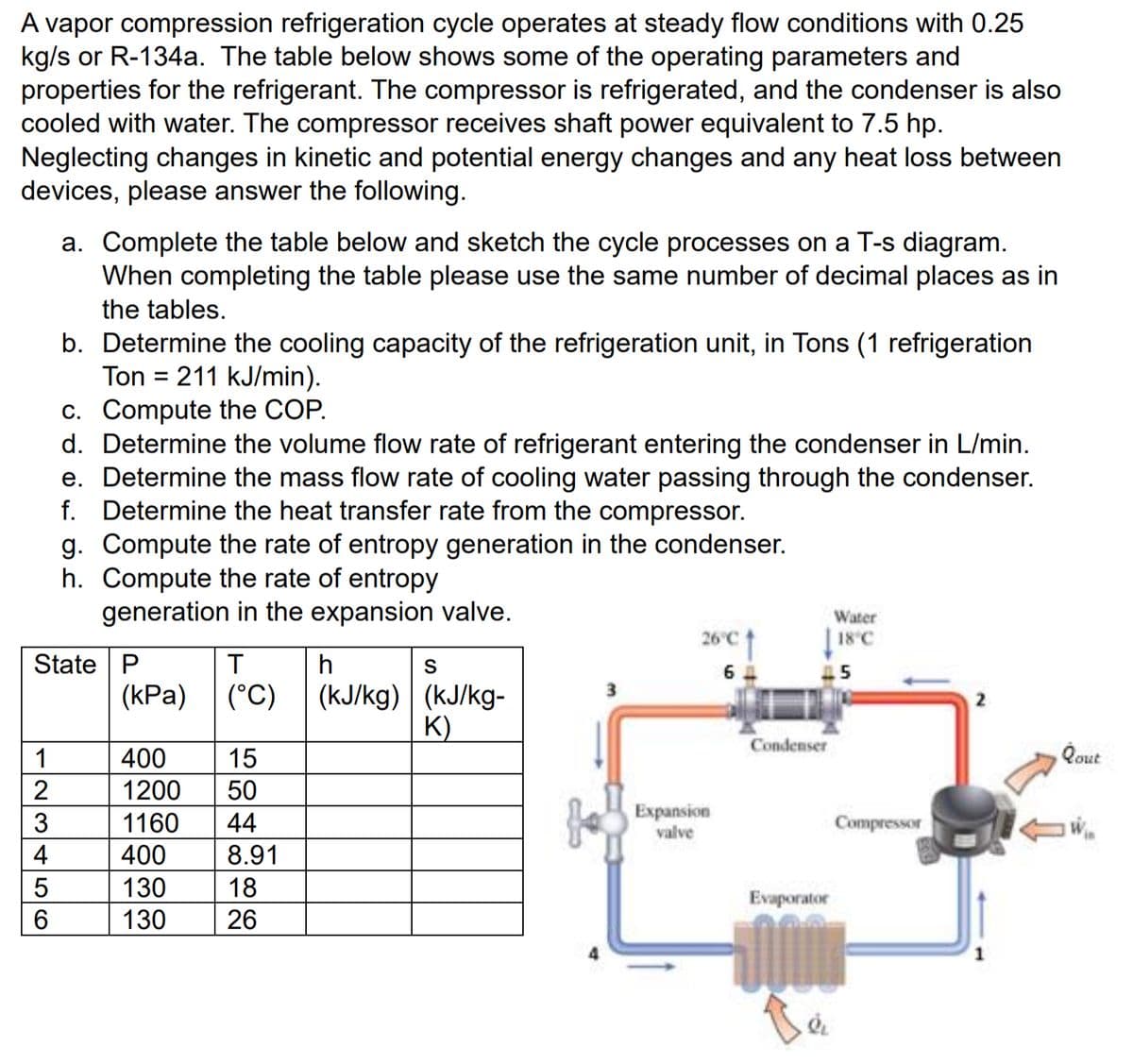A vapor compression refrigeration cycle operates at steady flow conditions with 0.25 kg/s or R-134a. The table below shows some of the operating parameters and properties for the refrigerant. The compressor is refrigerated, and the condenser is also cooled with water. The compressor receives shaft power equivalent to 7.5 hp. Neglecting changes in kinetic and potential energy changes and any heat loss between devices, please answer the following. a. Complete the table below and sketch the cycle processes on a T-s diagram. When completing the table please use the same number of decimal places as in the tables. b. Determine the cooling capacity of the refrigeration unit, in Tons (1 refrigeration Ton = 211 kJ/min). c. Compute the COP. d. Determine the volume flow rate of refrigerant entering the condenser in L/min. e. Determine the mass flow rate of cooling water passing through the condenser. f. Determine the heat transfer rate from the compressor. g. Compute the rate of entropy generation in the condenser. h. Compute the rate of entropy generation in the expansion valve. Water
A vapor compression refrigeration cycle operates at steady flow conditions with 0.25 kg/s or R-134a. The table below shows some of the operating parameters and properties for the refrigerant. The compressor is refrigerated, and the condenser is also cooled with water. The compressor receives shaft power equivalent to 7.5 hp. Neglecting changes in kinetic and potential energy changes and any heat loss between devices, please answer the following. a. Complete the table below and sketch the cycle processes on a T-s diagram. When completing the table please use the same number of decimal places as in the tables. b. Determine the cooling capacity of the refrigeration unit, in Tons (1 refrigeration Ton = 211 kJ/min). c. Compute the COP. d. Determine the volume flow rate of refrigerant entering the condenser in L/min. e. Determine the mass flow rate of cooling water passing through the condenser. f. Determine the heat transfer rate from the compressor. g. Compute the rate of entropy generation in the condenser. h. Compute the rate of entropy generation in the expansion valve. Water
Refrigeration and Air Conditioning Technology (MindTap Course List)
8th Edition
ISBN:9781305578296
Author:John Tomczyk, Eugene Silberstein, Bill Whitman, Bill Johnson
Publisher:John Tomczyk, Eugene Silberstein, Bill Whitman, Bill Johnson
Chapter45: Domestic Refrigerators And Freezers
Section: Chapter Questions
Problem 2RQ: The operating condition for the single compressor in a household refrigerator is the lowest box...
Related questions
Question
100%
A vapor compression refrigeration cycle operates at steady flow conditions with 0.25
kg/s or R-134a. The table below shows some of the operating parameters and
properties for the refrigerant. The compressor is refrigerated, and the condenser is also
cooled with water. The compressor receives shaft power equivalent to 7.5 hp.
Neglecting changes in kinetic and potential energy changes and any heat loss between
devices, please answer the following.
I understand how to fill the values but I get lost after that, need some help.

Transcribed Image Text:A vapor compression refrigeration cycle operates at steady flow conditions with 0.25
kg/s or R-134a. The table below shows some of the operating parameters and
properties for the refrigerant. The compressor is refrigerated, and the condenser is also
cooled with water. The compressor receives shaft power equivalent to 7.5 hp.
Neglecting changes in kinetic and potential energy changes and any heat loss between
devices, please answer the following.
123456
2
a. Complete the table below and sketch the cycle processes on a T-s diagram.
When completing the table please use the same number of decimal places as in
the tables.
5
b. Determine the cooling capacity of the refrigeration unit, in Tons (1 refrigeration
Ton = 211 kJ/min).
c. Compute the COP.
d. Determine the volume flow rate of refrigerant entering the condenser in L/min.
e. Determine the mass flow rate of cooling water passing through the condenser.
f. Determine the heat transfer rate from the compressor.
State P
g. Compute the rate of entropy generation in the condenser.
h. Compute the rate of entropy
generation in the expansion valve.
T
(kPa) (°C)
15
400
1200 50
1160
44
400
8.91
130
18
130
26
h
S
(kJ/kg) (kJ/kg-
K)
3
26°C
6
Expansion
valve
Condenser
Water
18°C
15
Compressor
Evaporator
TAMME
Qout
Expert Solution
This question has been solved!
Explore an expertly crafted, step-by-step solution for a thorough understanding of key concepts.
This is a popular solution!
Trending now
This is a popular solution!
Step by step
Solved in 4 steps with 56 images

Knowledge Booster
Learn more about
Need a deep-dive on the concept behind this application? Look no further. Learn more about this topic, mechanical-engineering and related others by exploring similar questions and additional content below.Recommended textbooks for you

Refrigeration and Air Conditioning Technology (Mi…
Mechanical Engineering
ISBN:
9781305578296
Author:
John Tomczyk, Eugene Silberstein, Bill Whitman, Bill Johnson
Publisher:
Cengage Learning

Refrigeration and Air Conditioning Technology (Mi…
Mechanical Engineering
ISBN:
9781305578296
Author:
John Tomczyk, Eugene Silberstein, Bill Whitman, Bill Johnson
Publisher:
Cengage Learning